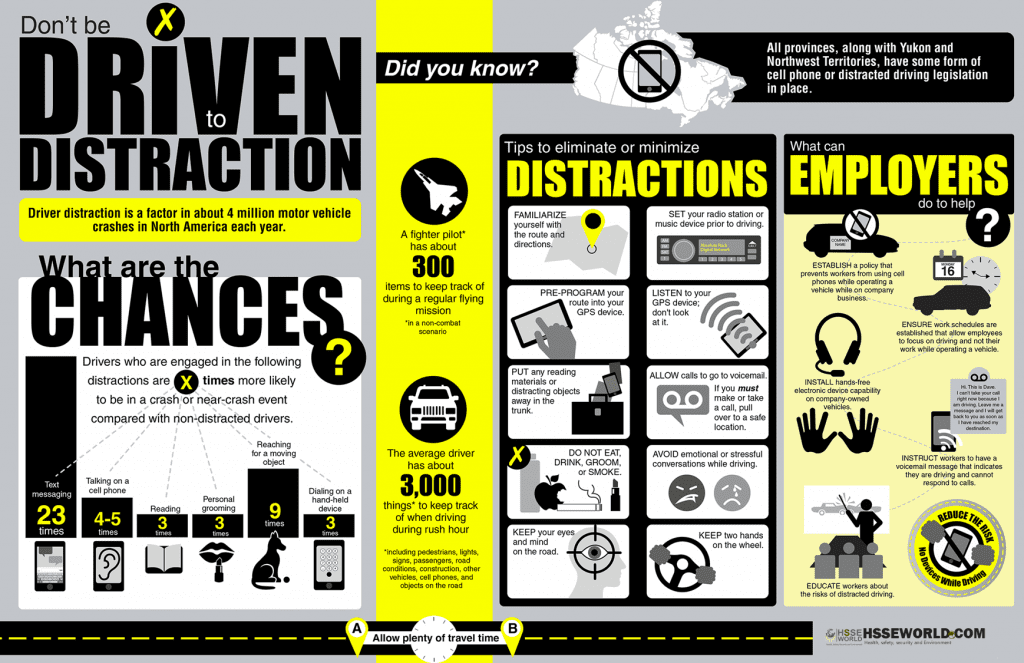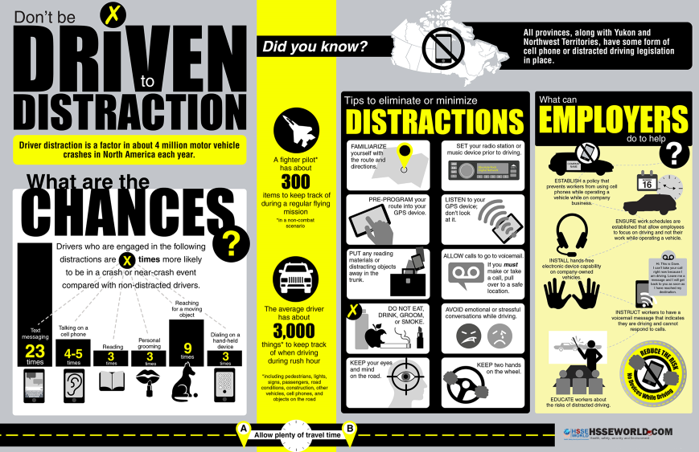For many drivers, operating a car or truck may seem second nature, whether it’s for personal or work use. However, no matter what the level of experience or comfort, driving requires your full attention.
With the popularity of cell phones, texting, talking, and e-mailing on the go are increasingly becoming factors in collisions. Share this infographic that highlights the importance of minimizing distractions, along with helpful tips for both drivers and employers to keep the focus squarely on the road.

Driver distraction is a factor in about 4 million motor vehicle crashes in North America each year.
What are the chances?
Drivers who are engaged in the following distractions are X times more likely to be in crash or near-crash event compared with non-distracted drivers
- Text messaging 23x
- Talking on a cell phone 4-5x
- Reading 3x
- Personal grooming 3x
- Reaching for a moving object 9x
- Dialing on a hand-held device 3x
Did you know?
All provinces, along with Yukon Territory and Northwest Territories, have some form of cell phone or distracted driving legislation in place.
A fighter pilot* has about 300 items to keep track of during a regular flying mission
* in a non-combat scenario.
The average driver has about 3,000 things* to keep track of when driving during rush hour
* including pedestrians, lights, signs, passengers, road conditions, construction, other vehicles, cell phones, and objects on the road.
Allow plenty of travel time
Tips to eliminate or minimize distractions
- Familiarize yourself with the route and directions.
- Set your radio station or music device prior to driving.
- Pre-program your route on your GPS device.
- Listen to your GPS device; don’t look at it.
- Put any reading materials or distracting objects away in the trunk.
- Allow calls to go to voicemail. If you must make or take a call, pull over and park at a safe location.
- Do not eat, drink, groom, or smoke.
- Avoid emotional or stressful conversations while driving.
- Keep your eyes and mind on the road.
- Keep two hands on the wheel.
( Download :Distracted-driving-safety-posters/ ).
What can employers do to help?
- Establish a policy that prohibits workers from using cell phones and similar devices while operating a company vehicle or operating their own vehicle while on company business.
- Ensure work schedules are established that allow employees to focus on driving and not their work while operating a vehicle.
- Install hands-free electronic device capability on company-owned devices.
- Instruct workers to have a voicemail message that indicates they are driving and cannot respond to calls.
- Educate workers on the risks of distracted driving.
What are some ‘good’ driving tips?
Most importantly, pay attention. Incidents occur because drivers were not aware of the conditions around them. Be aware and know that distractions can come from many sources at any time.
In general:
- Be well-rested.
- Do not consume alcohol, drugs, medications or other substances that may affect driving.
- Try not to think about personal or business matters, especially those that are upsetting.
- Do not use cellular phones or other devices if at all possible (including hands-free devices).
Before leaving:
- Stow belongings properly.
- Adjust the seat, mirrors, steering wheel, climate controls, etc.
- Select a radio station or have the music device ready.
- Plan your route, check the map or read the directions.
While driving:
- Pay attention.
- Keep distractions to a minimum (eating, drinking, smoking, adjustment to radio, cell phone use, etc.).
- Be aware of changing driving conditions such as the volume of traffic, weather, etc.
- Do not reach for items that have fallen or shifted unless absolutely necessary and can be done safely.
- Do not write notes while driving and/or talking.
- Do not glance at incoming messages.
- Be aware of other vehicles or persons who may be distracted.
DO
- Avoid using the phone or device.
- Have a voice mail option and allow it to pick up messages.
- Pull over to a safe location to make or take the call. Pull out of the flow of traffic especially when on a major highway (do not stop on the shoulder). Tell your caller you will phone them back after you have parked.
- Have a passenger answer or place the call.
- Use a hands-free device when using the phone (e.g., voice activation, single touch) but remember the activation process and conversation itself is still a distraction.
- Make sure other devices are mounted (not moving around) while driving.
- Pre-program commonly used numbers.
- Pause conversations if driving conditions become hazardous (e.g., rain, snow, construction, heavy traffic).
DO NOT
- Do not participate in very emotional or stressful conversations while driving.
- Do not take notes or look up information while driving. Ask the person on the other end to make notes for you if necessary.
- Do not use the device, including the text or e-mail feature even when at a stop sign or red light.
- Do not make gestures while talking and driving.
Reduce the risk – No devices while driving
( Read more: Take-action-against-distraction-staying-focused-to-avoid-injury/).
Download Infographic
Don’t be Driven to Distraction
More Photos
- What are the Best Practices for Managing Subcontractor Risk
- Photo of the day: 10 Essential Safety Tips for Driving in Hot Weather Conditions
- Photo of the day: best workplace safety tips
- Photo of the day: The Importance of Stop Work Authority in Maintaining Workplace Safety
- Photo of the day: Tomorrow’s Reward for Working Safely Today: Cultivating a Culture of Safety
- Photo of the day: Preventing slips and trips at work
- Photo of the day: Learn the DRSABCD action Plan
- Working with Electricity Electrical Accidents Guide for Electrical Workers
- Photo of the day: Hearing Protection Device Selection
- Photo of the day: If An Earthquake Shakes You-Infographic free
- Fire Safety Posters Free Download
- Photo of the day: First Aid for Electrical Burns-Infographic free
- Infographic: First Aid for Cuts and Scrapes free download
- Photo of The day: Work Safe with Lasers-Laser Safety free
- Photo of the day: Working Safely with chemicals and chemical Management
- Photo of the day: Safe work practices when using MEWPs ( updated)
- Photo of the day: Preventing Common Kitchen Hazards
- Photo of the day: Safe handling of Gas Cylinders and lecture bottles
- Photo of the day: Forklift Stability Triangle
- Photo of the day: Defective Tools Safe Work Practice
- Photo of the day: Lift With Your Legs Not With Your Back
- Photo of the day: First Aid for burns
- Photo of the day: The 7 Principles of HACCP
- Photo of the day: Working Safely with Suspended Loads
- Photo of the day: Heat Stroke First Aid and safety posters
- Photo of the day: Near-Miss Reporting and Posters
- Photo of the day: Ergonomic chair and office chair safety tips
- Photo of the day: Whole Body Vibration
- Photo of the day: Substation Safety Equipment
- Photo of the day: Bypassing Safety Controls Rules
- Photo of the day: Lightning Safety Tips
- Photo of the day: Overhead Power lines Clearance
- Photo of the day: Floor Marking
- Photo of the day: Types of Foot Protection
- Photo of the day: Types of Hand Protection
- Photo of the day: Lockout and Tagout Safety
- Photo of the day: Fall Protection Plans
- Photo of the day: Flood Safety Tips
- Photo of the day: Read All Labels Work safe
- Photo of the day: Run Project safely with Crane Hand Signals
- Photo of the day: Flagman and Traffic control
- Photo of the day: Managing Risks of Exposure to Solvents in the workplace
- Photo of the day: Scissor Lift Safety
- Photo of the day: HSE Bulletin Board
- Photo of the day: Arc-Fault Circuit Interrupters (AFCI)
- Photo of the day: Safe use of ladders and step ladders
- Photo of the day: Concrete Truck Driver Hand Signals
- Photo of the day: Extension Cord Safety Tips
- Photo of the day: Protect your Head
- Photo of the day: choosing the right Anchorage
- Photo of the day: Work-Related Asthma
- Photo of the day: Top FIVE Heavy Equipment Construction Site Safety Tips
- Photo of the day: sun safety in the workplace
- Photo of the day: Cannabis and Impairment in the Workplace
- Photo of the day: Position for safety and comfort-Safety Tips
- Photo of the day: Generator Safety
- Photo of the day: Controlling COVID-19 in the Workplace-Physical Barriers
- Photo of the day: Manual Material handling
- Photo of the day: Personal Protective Equipment last resort
- Photo of the day: WHMIS 2015 – Pictograms
- Photo of the day: Indoor Air Quality
- Photo of the day: Noise in the affected workplace
- Photo of the day: Fatigue at Work
- Photo of the day: Don’t be Driven to Distraction
- Photo of the day: working in heat and Humidex Rating
- How to use Plate Clamps Safely: Safety Moment#34
- Photo of the day: Sitting at work
- Photo of the day: 5 ways to reduce the risk of Slipping and Tripping
- Photo of the day: Preventing the spread of contagious illness
- Photo of the day: Incident Investigations
- Photo of the day: 10 Scaffold Safety Essentials
- Photo of the day: Effective Health and Safety Committees
- Photo of the day: New worker Orientation & Safety Orientation checklist
- Photo of the day: Workplace Inspection
- Photo of the day: musculoskeletal disorders
- Photo of the day: Emergency preparedness in the workplace
- Photo of the day: Mental health in the workplace
- Photo of the day: Trenching Safety Tips That Can Save a Life
- Photo of the day: Dangerous Goods Classes
- Photo of the day: Safety Equipment for Confined Spaces
- Photo of the day: Tips to reduce Heat stress in the workplace
- Photo of the day: hierarchy of controls
- Your steps to chemical safety
- H2S Gas and how to handle its Emergency
- Photo of the day: Importance of Mock drill and Fire Action Emergency Procedure
- Photo of the day: Choosing the Right Face Mask and the difference between a respirator and face mask
- Photo of the day: Confined space safety Precautions
- Breath Safely: The Proper Use of Respiratory Protection
- Photo of the day: Electric shock survival
- Photo of the day: Chemical Spill Emergency Response
- Photo of the day: Construction Site fire Safety




